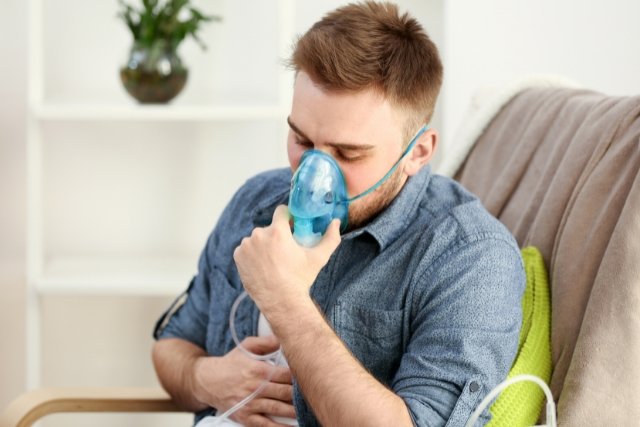Respiratory Disease

The second most important symptom of lung disease is dyspnea, or shortness of breath. This sensation, of complex origin, may arise acutely, as when a foreign body is inhaled into the trachea, or with the onset of a severe attack of asthma. More often, it is insidious in onset and slowly progressive. What is noted is a slowly progressive difficulty in completing some task, such as walking up a flight of stairs, playing golf, or walking uphill. The shortness of breath may vary in severity, but in diseases such as emphysema (see below Pulmonary emphysema), in which there is irreversible lung damage, it is constantly present. It may become so severe as to immobilize the victim, and tasks such as dressing cannot be performed without difficulty. Severe fibrosis of the lung, resulting from occupational lung disease or arising from no identifiable antecedent condition, may also cause severe and unremitting dyspnea. Dyspnea is also an early symptom of congestion of the lung as a result of impaired function of the left ventricle of the heart. When this occurs, if the right ventricle that pumps blood through the lungs is functioning normally, the lung capillaries become engorged, and fluid may accumulate in small alveoli and airways. It is commonly dyspnea that first causes a patient to seek medical advice, but absence of the symptom does not mean that serious lung disease is not present, since, for example, a small lung cancer that is not obstructing an airway does not produce shortness of breath.
Defenses of the respiratory system
Exposed as it is to the outside environment, the respiratory tract possesses a complicated but comprehensive series of defenses against inhaled material. As air passes through the nose, large particles of debris are filtered out by cilia and by mucus that is secreted from the mucous membrane lining the nasal cavity. The air then travels through the pharynx, which is the last portion of the upper airway, through the larynx, which is the beginning portion of the lower airways, and into the trachea. Further filtration of the air occurs as it passes over cilia and sticky layers of mucus in the trachea. In addition, lymphatic vessels in the wall of the trachea transport cells of the immune system, such as lymphocytes and macrophages, that act to trap and destroy foreign particles. Bands of muscle that surround the cartilage of the trachea play an important role in narrowing the airway during coughing, thus providing a forceful defense mechanism by which sputum and other substances can be quickly expelled from the respiratory tract.
In the bronchial tree, cilia beat in unison in one direction, moving substances up and out of the airways. Covering the cilia in the bronchioles and small bronchi is a thin layer of fluid, which increases in thickness and becomes layered with mucus as the small bronchi converge into the large bronchi. When the cilia beat, foreign particles are transported along in the fluid and mucus layers. This system, known as the mucociliary escalator, carries debris as far as the pharynx, where the fluid and mucus is then swallowed and the debris eliminated by the digestive system.
Methods of investigation
Physical examination of the chest remains important, as it may reveal the presence of an area of inflammation, a pleural effusion, or an airway obstruction. Methods of examination include physical inspection and palpation for masses, tender areas, and abnormal breathing patterns; percussion to gauge the resonance of the underlying lung; and auscultation (listening) with a stethoscope to determine pitch and loudness of breath sounds. The sounds detected with a stethoscope may reveal abnormalities of the airways, the lung tissue, or the pleural space. Examination of the sputum for bacteria allows the identification of many infectious organisms and the institution of specific treatment; sputum examination for malignant cells is occasionally helpful.
Lung transplantation
Scientists performed the first single-lung transplant in 1963, though the patient survived just 18 days. Success with long-term survival came in 1983 for single-lung transplantation and in 1986 for double-lung transplantation. In the following decades, persons severely disabled by cystic fibrosis, emphysema, sarcoidosis, pulmonary fibrosis, or severe primary pulmonary hypertension were able to achieve nearly normal lung function several months after the procedure. By the early 2000s, median survival for lung transplant patients had reached more than five years. The number of procedures carried out annually, however, was limited by a shortage of donor lungs.

